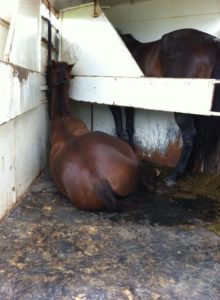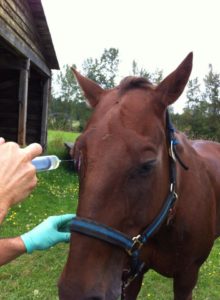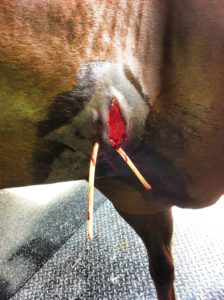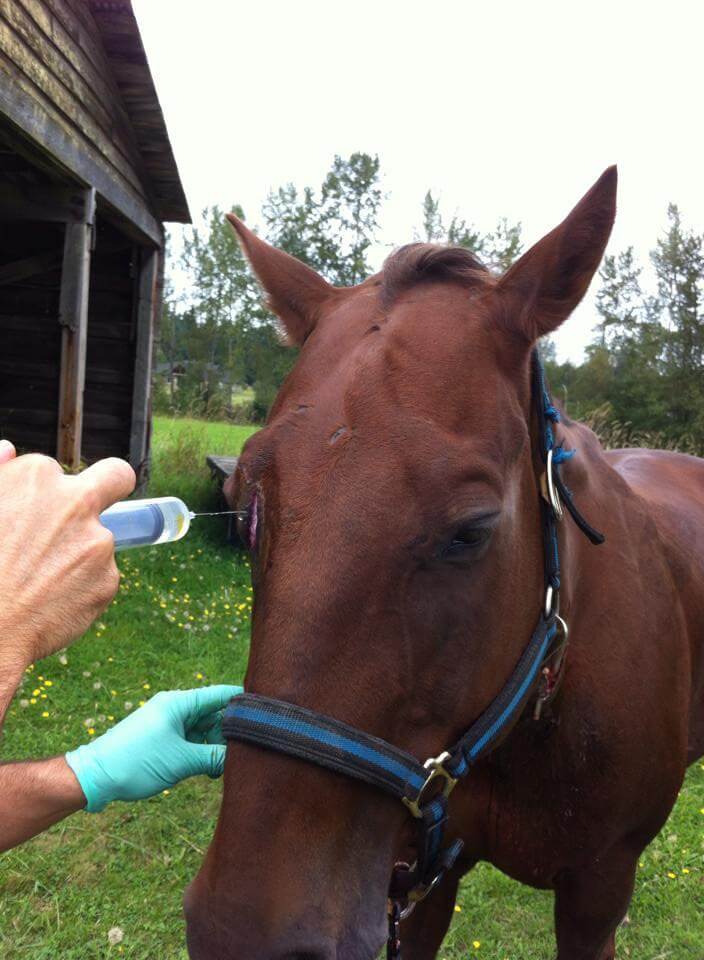Caring for Your Horse in an Emergency
by Dave Sauter, DVM
Developing knowledge and skills in equine first aid and emergency care is important for horse owners. Compared to other animals, horses seem to have more than their share of injuries, colic and other problems. For thousands of years, horses have been bred for strength, speed and athleticism. Because they are performing athletes, unlike animals used for food and fiber, injuries are more likely. Horses are also herbivorous herd animals and, as such, have strong fright, flight and fight instincts. Within their herds, they have strong dominance hierarchy. So, it is no surprise that horses have more problems.
There are several important principles to follow when encountering health problems or emergencies:
- Be safe. Injured, painful, panicked or distressed horses can behave much differently than normal horses. You won’t be able to provide for their care and needs if you get injured. For your sake, and the sake of the horse who needs your help, pay utmost attention to safety.
- Be calm. This is easier said than done. Horses have extremely keen senses and will respond better if your emotions are under control. Remaining calm will help you be more capable and efficient in providing the help that is necessary in the moment.

Bridget Whitson’s horse, Jaxon, was injured after falling in the horse trailer. This required calm and careful maneuvering, using two people, to get him safely out. Photo credit Bridget Whitson - Be prepared. Being prepared can help keep emotions in check. Have an action plan, keep a well-stocked first aid kit, and learn skills. Being prepared helps one focus on useful action and provides a sense of control, which will naturally help stabilize emotions.
- Be alert. Keep an eye on the big picture as you focus on the immediate problem(s) at hand. For example, a colicky horse that is going down should be moved to an open area free of obstacles. Another example is if a horse falls in a warm-up area and either the horse or its rider are injured. Other riders in the immediate vicinity should be instructed to calmly dismount and vacate the area.
- Get help. Get your questions answered, get advice from experienced and trusted sources and get support and assistance on site when necessary. For instance, many treatments require assistance—someone to hold and watch while the procedure is performed.
- Record. Jotting down notes of useful information and observations, along with the time, can be helpful. In the confusion of an emergency, or if the problem develops over some time, remembering what and when events occur can get lost. Having written records can help paint a more accurate picture and also help recognize trends or changes.
The basic exam
Whether dealing with obvious problems, such as a bleeding wound or serious lameness, or a more subtle one, such as lethargy or lack of appetite, a basic equine exam will provide a more complete picture. The recurring mantra when it comes to the basic exam is to know what is normal for your horse. This includes general things such as daily habits, general behavior, usual stool in terms of quantity, frequency, and consistency, water consumption, coordination, energy levels, mental alertness, etc. Start with observations such as these “from a distance.” Get an overview of the setting to help decide the safest and most suitable way to examine and treat the horse. The basic exam includes checking vital signs:
- Temperature. The horse’s temperature is taken rectally. Rapid reading digital thermometers are usually used, along with a little lubricant to make it less irritating. Normal temperature in the horse is 99.0°F to 101.0°F.
- Pulse rate or heart rate. The mandibular artery can be found on the underside and inside of the mandible. It feels cord-like and should be pressed toward the mandibular bone to keep it still while you count the pulsations. Alternatively, listen to the heart by placing a stethoscope against the lower chest near the left elbow. Two sounds, “lub-dub,” represent one heart beat. Generally count the pulsations or heart beats for 15 seconds and multiply by 4 to get the beats per minute. Normal for the adult horse is 28 to 44 beats per minute.
- Mucus membranes. Gently lift the corner of the upper lip to examine the mucus membranes or gums for color. A medium pink color is normal. Examples of abnormal color include pale, red, bluish, and yellowish (jaundice). A pen light can help, especially if in a dark barn or shadow.
- Capillary Refill Time (CRT). Press the horse’s gums firmly with a fingertip, pushing the blood out of the tissue. Once released the blood and color should return quickly, normally in a second or less. CRT is a reflection of hydration and blood pressure.
- Skin elasticity. This is another measure of hydration. A common place to check skin elasticity is near the base of the neck. Grasp a fold of skin and pull it away from the body. After releasing, watch how quickly it bounces back. If normal, this should happen immediately.
- Check extremities for heat, swelling, pain or abnormal coldness
Practice the above exam so you and, even more importantly, your horse become comfortable with it. These procedures require contact with sensitive areas and repetition will help the horse learn to tolerate it without fear or resistance.

Treatment skills
Developing treatment skills is especially helpful when dealing with minor situations when a veterinarian is not necessary, when a veterinarian is unavailable (while traveling or on the trail) or for follow-up treatments after initial care by a veterinarian. Helpful skills include bandaging techniques, administering oral medication, administering injectable medication and administering eye medication. In addition to your veterinarian, workshops or seminars, books and trusted websites can be good resources for information on proper techniques.
When to call the vet
As part of your emergency plan, have important phone numbers (veterinarian, trainer, friends, farrier, etc.) easily accessible such as posted in the barn, written on a white board, and on your cellular phone contact list. As long as you don’t abuse the privilege, most equine veterinarians are open to answering questions and are an excellent resource. Although many minor situations can be handled by experienced owners (such as minor abrasions, sprains and strains) here are some examples of situations when you should call your veterinarian:

Photo credit Bridget Whitson
- Wounds with significant bleeding.
- Any wounds over vital areas such as joints or tendon sheaths.
- Wounds that require sutures. If unsure, clean and clip hair to get a better look.
- Colic – avoid medicating before the vet arrives.
- Eyes problems, especially if there is squinting, tearing or cloudiness.
- Choke
- Severe lameness
- Tying-up
- Fever
- Listlessness/lethargy
- Loss of appetite
- Allergic reactions
- Labored breathing
- Sudden lack of coordination
HighlightOnline resources:
- First Aid Kit suggested supply list: www.kulshanvet.com – equine section
- How to perform intramuscular injections: www.kulshanvet.com – equine section
- General information: www.aaep.org – owner section
- General information: www.thehorse.com
Preparation, planning, practice and having skills and supplies available go a long way toward providing first aid and medical assistance for your horse(s), when necessary.
Published February 2014 Issue

Dave Sauter is a Minnesota native and graduated from the University of Minnesota in 1987. Following graduation he interned at Rood and Riddle Equine Hospital in Lexington, Kentucky. After this internship, he continued to work exclusively with horses for another five years in Kentucky before moving out West and joining Kulshan Veterinary Hospital in Lynden, WA. He is a member of the AAEP, AVMA and the WSVMA. For more information about Kulshan Veterinary Hospital call 360-354-5095 or email [email protected]. www.KulshanVet.com








